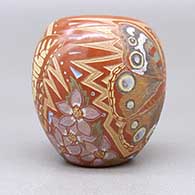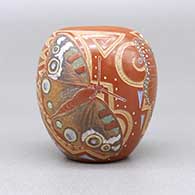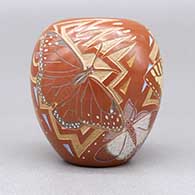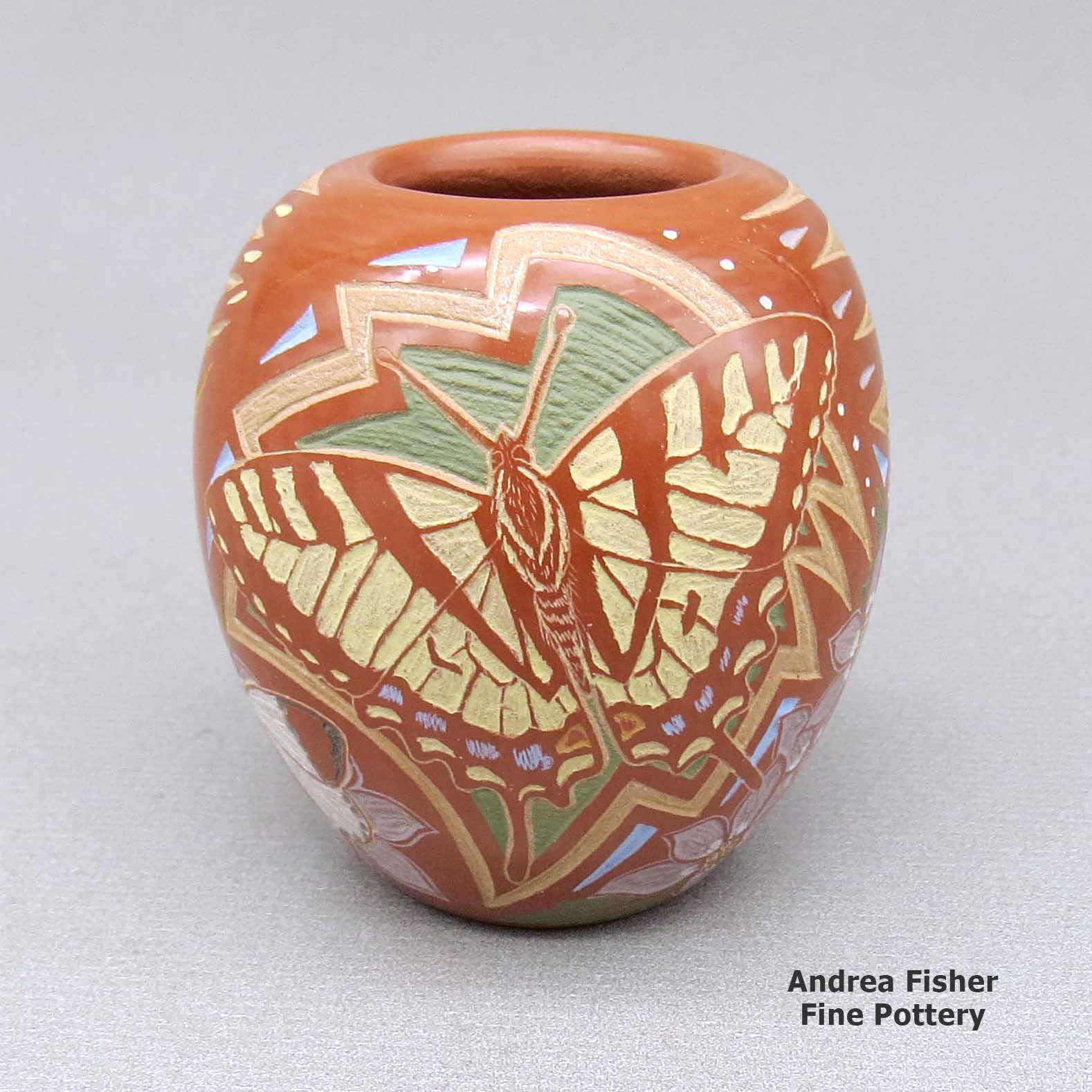
Santa Clara
$ SOLD
josc3k114
Small polychrome jar with micaceous slip details and a sgraffito and intricately painted butterfly, flower, and geometric design
2 in L by 2 in W by 2.25 in H
Condition: Very good
Signature: Jennifer and Mike Moquino, with mountain hallmark
Tell me more! Buy this piece!
(505) 986-1234 - www.andreafisherpottery.com - All Rights Reserved
Jennifer Moquino
Santa Clara
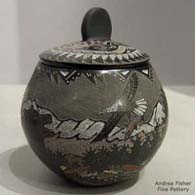
Jennifer (Tafoya) Moquino was born to Ray Tafoya and Emily (Suazo) Tafoya of Santa Clara Pueblo in 1977. Both she and her husband, Michael Moquino (son of Corn Moquino), grew up in households where some aspect in the making of pottery was unfolding in front of them on a daily basis. It is said she made her first piece of pottery when she was six years old.
Jennifer submitted a figure for judging in the 1992 Santa Fe Indian Market Student division (ages 13 through 18) and earned her first First Place ribbon. In 1996 she earned another First Place ribbon at Santa Fe for a figure. Jennifer and Michael became a husband-and-wife team in 1998 and, together, are still earning ribbons for their work.
Jennifer and Mike specialize in making miniature vases and seed pots. Mike makes most of the pieces and Jennifer does the sgraffito designs. Her favorite designs incorporate birds, insects, animals and flowers. Around 2015 Mike started making tiles that Jennifer etched and painted with a mix of Japanese animé designs with Pueblo themes and colors.
Some Awards Jennifer has earned
- 2023 Santa Fe Indian Market, Division C: Pottery, Best of Class
- 2023 Santa Fe Indian Market, Division C, Category 701 - Carved or incised, black or red, under 8 inches, Second Place
- 2023 Santa Fe Indian Market, Division D, Best of Division
- 2023 Santa Fe Indian Market, Category 801 - Sgraffito, any form, First Place
- 2023 Santa Fe Indian Market, Category 802 - Carved, any form, Second Place
- 2019 Santa Fe Indian Market: Tony Da Memorial Award: "New Vision in Pueblo Pottery." For excellence in the creative and innovative use of traditional materials and techniques in creating new styles in Pueblo Pottery
- 2019 Santa Fe Indian Market, Classification II - Pottery, Division E - Contemporary pottery, any form or design, using commercial clays/glazes, all firing techniques, Category 906 - Sgraffito and carved, any form: First Place
- 2019 Santa Fe Indian Market, Classification II - Pottery, Division F - Miniature pots, individual pieces under 3" in any direction, Category 1003 - Figures, including sets: First Place - 2018 Santa Fe Indian Market, Classification II - Pottery, Division C - Traditional Burnished Black or Red Ware; Incised, Painted or Carved, Category 701 - Carved or incised, black or red, under 8 inches: Second Place
- 2018 Heard Museum Guild Indian Fair & Market, Classification II - Pottery, Division A - Painted, native clay, hand built, fired out-of-doors: Second Place. Awarded for a collaborative work with Jason Ebelacker: Signs of Spring Water Jar
- 2017 Heard Museum Guild Indian Fair & Market, Classification II Pottery, Division F - Any Design or Form with Non-native Materials, Includes Kiln Fired Pottery: First Place. Awarded for collaborative artwork with Jason Ebelacker: Autunmoki
- 2016 Heard Museum Guild Indian Fair & Market, Classification II - Pottery, Division D - Traditional - Native Clay, Hand Built, Figurative: Second Place
- 2016 Heard Museum Guild Indian Fair & Market, Classification II - Pottery, Division F - Non-Traditional Design or Form with Non-Native Materials: First Place, with Christopher Youngblood Cutler - 2014 Heard Museum Guild Indian Fair & Market, Classification II - Pottery, Division E - Non-traditional Design or Form with Native Materials: Second Place. Award for collaborative work with Russell Sanchez. Awarded for artwork: Dragon Water Jar
- 2014 Heard Museum Guild Indian Fair & Market, Classification II - Pottery, Division F - Non-traditional Design or Form with non-native Materials: First Place. Awarded for artwork: Feathered Serpent - 2013 Heard Museum Guild Indian Fair & Market, Classification II - Pottery: Best of Classification, with Russell Sanchez
- 2013 Heard Museum Guild Indian Fair & Market, Classification II - Pottery, Division D - Traditional - Native Clay, Hand Built, Figurative: First Place, with Russell Sanchez
- 2013 Heard Museum Guild Indian Fair & Market, Classification II - Pottery - Division F - Non-Traditional Design or Form with Non-Native Materials: First Place, with Russell Sanchez - 2012 Heard Museum Guild Indian Fair & Market, Classification II - Pottery, Division C - Traditional, Native Clay, Hand Built, Carved: First Place, with Michael Lee
- 2012 Heard Museum Guild Indian Fair & Market, Classification II - Pottery, Division G - Miniatures Not to Exceed 3": Second Place - 2008 Heard Museum Guild Indian Fair & Market, Classification II - Pottery, Division G - Pottery, Miniatures: Second Place
- 2004 Santa Fe Indian Market, Classification II - Pottery: Best of Classification
- 2004 Santa Fe Indian Market, Classification II - Pottery, Division H - Non-Traditional Pottery using Traditional Materials and Techniques with Non-traditional Decorative Elements: Best of Division
- 2004 Santa Fe Indian Market, Classification II - Pottery, Division H - Non-Traditional Pottery using Traditional Materials and Techniques with Non-traditional Decorative Elements, Category 1507 - Sgraffito: First Place
- 2004 Santa Fe Indian Market, Classification II - Pottery, Division J - Non-Traditional Ceramics, All Materials, All Techniques, with or without Decorative Elements, Any Form, Any Design: Second Place
Santa Clara Pueblo

Ruins at Puye Cliffs, Santa Clara Pueblo
Santa Clara Pueblo straddles the Rio Grande about 25 miles north of Santa Fe. Of all the pueblos, Santa Clara has the largest number of potters.
The ancestral roots of the Santa Clara people have been traced to the pueblos in the Mesa Verde region in southwestern Colorado. When that area began to get dry between about 1100 and 1300, some of the people migrated to the Chama River Valley and constructed Poshuouinge (about 3 miles south of what is now Abiquiu on the edge of the mesa above the Chama River). Eventually reaching two and three stories high with up to 700 rooms on the ground floor, Poshuouinge was inhabited from about 1375 to about 1475. Drought then again forced the people to move, some of them going to the area of Puye (on the eastern slopes of the Pajarito Plateau of the Jemez Mountains) and others to Ohkay Owingeh (San Juan Pueblo, along the Rio Grande). Beginning around 1580, drought forced the residents of the Puye area to relocate closer to the Rio Grande and they founded what we now know as Santa Clara Pueblo on the west bank of the river, between San Juan and San Ildefonso Pueblos.
In 1598 Spanish colonists from nearby Yunque (the seat of Spanish government near San Juan Pueblo) brought the first missionaries to Santa Clara. That led to the first mission church being built around 1622. However, the Santa Clarans chafed under the weight of Spanish rule like the other pueblos did and were in the forefront of the Pueblo Revolt of 1680. One pueblo resident, a mixed black and Tewa man named Domingo Naranjo, was one of the rebellion's ringleaders. When Don Diego de Vargas came back to the area in 1694, he found most of the Santa Clarans on top of nearby Black Mesa (with the people of San Ildefonso). An extended siege didn't subdue them so eventually, the two sides negotiated a treaty and the people returned to their pueblo. However, successive invasions and occupations by northern Europeans took their toll on the tribe over the next 250 years. The Spanish flu pandemic in 1918 almost wiped them out.
Today, Santa Clara Pueblo is home to as many as 2,600 people and they comprise probably the largest per capita number of artists of any North American tribe (estimates of the number of potters run as high as 1-in-4 residents).
Today's pottery from Santa Clara is typically either black or red. It is usually highly polished and designs might be deeply carved or etched ("sgraffito") into the pot's surface. The water serpent, ("avanyu"), is a traditional design motif of Santa Clara pottery. Another motif comes from the legend that a bear helped the people find water during a drought. The bear paw has appeared on their pottery ever since.
One of the reasons for the distinction this pueblo has received is because of the evolving artistry the potters have brought to the craft. Not only did this pueblo produce excellent black and redware, several notable innovations helped move pottery from the realm of utilitarian vessels into the domain of art. Different styles of polychrome redware emerged in the 1920's-1930's. In the early 1960's experiments with stone inlay, incising and double firing began. Modern potters have also extended the tradition with unusual shapes, slips and designs, illustrating what one Santa Clara potter said: "At Santa Clara, being non-traditional is the tradition." (This refers strictly to artistic expression; the method of creating pottery remains traditional).
Santa Clara Pueblo is home to a number of famous pottery families: Tafoya, Baca, Gutierrez, Naranjo, Suazo, Chavarria, Garcia, Vigil, Tapia - to name a few.



Santa Clara Pueblo at Wikipedia
Pueblos of the Rio Grande, Daniel Gibson, ISBN-13:978-1-887896-26-9, Rio Nuevo Publishers, 2001
Upper photo courtesy of Einar Kvaran, Creative Commons Attribution-Share Alike 3.0 Unported License
Micaceous Clay Pottery

Angie Yazzie
Taos
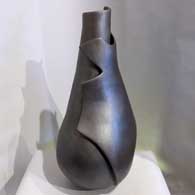
Christine McHorse
Navajo
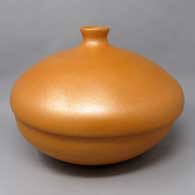
Clarence Cruz
San Juan/Ohkay Owingeh
Micaceous clay pots are the only truly functional Pueblo pottery still being made. Some special micaceous pots can be used directly on the stove or in the oven for cooking. Some are also excellent for food storage. Some people say the best beans and chili they ever tasted were cooked in a micaceous bean pot. Whether you use them for cooking or storage or as additions to your collection of fine art, micaceous clay pots are a beautiful result of centuries of Pueblo pottery making.
Between Taos and Picuris Pueblos is US Hill. Somewhere on US Hill is a mica mine that has been in use for centuries. Excavations of ancient ruins and historic homesteads across the Southwest have found utensils and cooking pots that were made of this clay hundreds of years ago.
Not long ago, though, the making of micaceous pottery was a dying art. There were a couple potters at Taos and at Picuris still making utilitarian pieces but that was it. Then Lonnie Vigil felt the call, returned to Nambe Pueblo from Washington DC and learned to make the pottery he became famous for. His success brought others into the micaceous art marketplace.
Micaceous pots have a beautiful shimmer that comes from the high mica content in the clay. Mica is a composite mineral of aluminum and/or magnesium and various silicates. The Pueblos were using large sheets of translucent mica to make windows prior to the Spaniards arriving. It was the Spanish who brought a technique for making glass. There are eight mica mining areas in northern New Mexico with 54 mines spread among them. Most micaceous clay used in the making of modern Pueblo pottery comes from several different mines near Taos Pueblo.
As we understand it, potters Robert Vigil and Clarence Cruz have said there are two basic kinds of micaceous clay that most potters use. The first kind is extremely micaceous with mica in thick sheets. While the clay and the mica it contains can be broken down to make pottery, that same clay has to be used to form the entire final product. It can be coiled and scraped but that final product will always be thicker, heavier and rougher on the surface. This is the preferred micaceous clay for making utilitarian pottery and utensils. It is essentially waterproof and conducts heat evenly.
The second kind is the preferred micaceous clay for most non-functional fine art pieces. It has less of a mica content with smaller embedded pieces of mica. It is more easily broken down by the potters and more easily made into a slip to cover a base made of other clay. Even as a slip, the mica serves to bond and strengthen everything it touches. The finished product can be thinner and have a smoother surface. As a slip, it can also be used to paint over other colors of clay for added effect. However, these micaceous pots may be a bit more water resistant than other Pueblo pottery but they are not utilitarian and will not survive utilitarian use.
While all micaceous clay from the area of Taos turns golden when fired, it can also be turned black by firing in an oxygen reduction atmosphere. Black fire clouds are also a common element on golden micaceous pottery.
Mica is a relatively common component of clay, it's just not as visible in most. Potters at Hopi, Zuni and Acoma have produced mica-flecked pottery in other colors using finely powdered mica flakes. Some potters at San Ildefonso, Santa Clara, Jemez and San Juan use micaceous slips to add sparkle to their pieces.
Potters from the Jicarilla Apache Nation collect their micaceous clay closer to home in the Jemez Mountains. The makeup of that clay is different and it fires to a less golden/orange color than does Taos clay. Some clay from the Picuris area fires less golden/orange, too. Christine McHorse, a Navajo potter who married into Taos Pueblo, uses various micaceous clays on her pieces depending on what the clay asks of her in the flow of her creating.
There is nothing in the makeup of a micaceous pot that would hinder a good sgraffito artist or light carver from doing her or his thing. There are some who have learned to successfully paint on a micaceous surface. The undecorated sparkly surface in concert with the beauty of simple shapes is a real testament to the artistry of the micaceous potter.
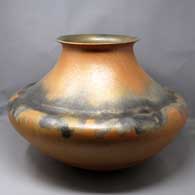
Lonnie Vigil
Nambe
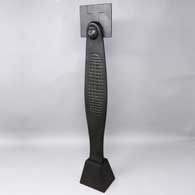
Robert Vigil
Nambe

Preston Duwyenie
Hopi
Moquino Family Tree
Disclaimer: This "family tree" is a best effort on our part to determine who the potters are in this family and arrange them in a generational order. The general information available is questionable so we have tried to show each of these diagrams to living members of each family to get their input and approval, too. This diagram is subject to change should we get better info.
- Benina (Zia) and Augustin (Hopi) Moquino
- Reyes Homer and Marie Homer
- Robert Allen Homer (1956-)
- Bob Moquino
- Corn Moquino and Christine Herrera (Santa Clara)
- Bernice Moquino (1970-) and Martin Barela
- Christopher Moquino
- James Moquino Sr. and Yolanda Velarde
- Keith Chavez
- Camille Moquino (1979-)
- Mario Thomas
- James Moquino Jr.
- Mark Moquino
- Martin Moquino
- Marvin and Delores Moquino
- Matthew Moquino
- Melvin Moquino
- Michael Moquino and Jennifer (Tafoya) Moquino (1977-)
- Willie Moquino
- Ester Talles
Some of the above info is drawn from Pueblo Indian Pottery, 750 Artist Biographies, by Gregory Schaaf, © 2000, Center for Indigenous Arts & Studies
Other info is derived from personal contacts with family members and through interminable searches of the Internet.
Copyright © 1998-2024 by


